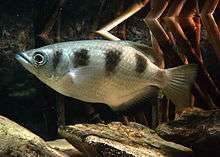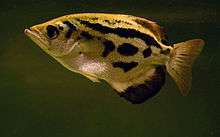Archerfish
| Archerfish | |
|---|---|
 | |
| Toxotes jaculatrix | |
| Scientific classification | |
| Kingdom: | Animalia |
| Phylum: | Chordata |
| Class: | Actinopterygii |
| Order: | Perciformes |
| Family: | Toxotidae Cuvier, 1816 |
| Genus: | Toxotes Cuvier, 1816 |
The archerfish (spinner fish or archer fish) form a monotypic family, Toxotidae, of fish known for their habit of preying on land-based insects and other small animals by shooting them down with water droplets from their specialized mouths. The family is small, consisting of ten species in a single genus Toxotes. Most species live in fresh water rivers, streams and pools, but two or three are euryhaline, inhabiting both fresh and brackish water habitats such as estuaries and mangroves.[1][2] They can be found from India and Sri Lanka, through Southeast Asia, to Northern Australia and Melanesia.[3]
Archerfish or spinnerfish bodies are deep and laterally compressed, with the dorsal fin, and the profile a straight line from dorsal fin to mouth. The mouth is protractile, and the lower jaw juts out. Sizes are fairly small, typically up to about 12–18 cm (5–7 in), but T. chatareus can reach 40 cm (16 in).[3][4]
Archerfish are popular for aquaria,[5] but difficult to feed since they prefer live prey.
Capture of prey
.png)
Archerfish are remarkably accurate in their shooting; an adult fish almost always hits the target on the first shot. Although it is presumed that all archerfish species do this, it has only been confirmed from T. blythii, T. chatareus and T. jaculatrix.[1] They can bring down insects and other prey[6] up to 3 m (10 ft) above the water's surface.[7] This is partially due to their good eyesight, but also to their ability to compensate for the refraction of light as it passes through the air-water interface when aiming at their prey.[8] They typically spit at prey at a mean angle of about 74° from the horizontal but can still aim accurately when spitting at angles between 45° and 110°.[9]
When an archerfish selects its prey, it rotates its eye so that the image of the prey falls on a particular portion of the eye in the ventral temporal periphery of the retina,[10] and its lips just break the surface, squirting a jet of water at its victim. The archerfish does this by forming a small groove in the roof of its mouth and its tongue into a narrow channel. It then fires by contracting its gill covers and forcing water through the channel, shooting a stream that, shaped by its mouth parts, travels faster at the rear than at the front. This speed differential causes the stream to become a blob directly before impact as the slower leading water is overtaken by the faster trailing water, and it is varied by the fish to account for differences in range. It also makes this one of the few animals that both make and use tools, as they both utilise the water and shape it to make it more useful to them.[11][12] Archerfish have been known to send a stream up to 5 metres (16 ft) but can shoot insects only up to 1–2 metres (3 ft 3 in–6 ft 7 in) away due to their limited accuracy. They are persistent, however, and will make multiple shots if the first one fails.[13]
Young archerfish start shooting when they are about 2.5 cm (1 in) long but are inaccurate at first and must learn from experience. During this learning period, they hunt in small schools. This way, the probability is enhanced that at least one jet will hit its target. It has also been determined in an experimental context that archerfish were able to benefit from observational learning by watching a performing group member shoot, without having to practice:
This instance of social learning in a fish is most remarkable as it could imply that observers can ‘‘change their viewpoint,’’ mapping the perceived shooting characteristics of a distant team member into angles and target distances that they later must use to hit.[8]
An archerfish will often leap out of the water and grab an insect in its mouth if it happens to be within reach. Individuals typically prefer to remain close to the surface of the water.[11]
New research has found that archerfish also use jets to hunt underwater prey, such as those embedded in silt. It is not known whether they learned aerial or underwater shooting first, but the two techniques may have evolved in parallel, as improvements in one can be adapted to the other.[14]
Species
There are 10 valid species, all in the genus Toxotes:[1][3][15]
- Toxotes blythii Boulenger, 1892 - clouded archerfish, zebra archerfish
- Toxotes chatareus (Hamilton, 1822) - largescale archerfish
- Toxotes jaculatrix (Pallas, 1767) - banded archerfish
- Toxotes kimberleyensis Allen, 2004 - Kimberley archerfish, western archerfish
- Toxotes lorentzi Weber, 1910 - primitive archerfish
- Toxoter mekongensis Kottelat & Tan, 2018
- Toxotes microlepis Günther, 1860 - smallscale archerfish
- Toxotes oligolepis Bleeker, 1876 - big scale archerfish
- Toxoter siamensis Kottelat & Tan, 2018
- Toxoter sundaicus Kottelat & Tan, 2018
Timeline

See also
References
- 1 2 3 Maurice Kottelat; Tan Heok Hui (2018). "Three new species of archerfishes from the freshwaters of Southeast Asia (Teleostei: Toxotidae) and notes on Henri Mouhot's fish collections". Ichthyological Exploration of Freshwaters. IEF-952: 1–19. doi:10.23788/IEF-952.
- ↑ Arthington, A., and McKenzie, F. "Review of Impacts of Displaced/Introduced Fauna Associated with Inland Waters. Archived December 1, 2008, at the Wayback Machine." Environment Australia Archived April 25, 2009, at the Wayback Machine. Australia: State of the Environment Technical Paper Series (Inland Waters), Series 1, 1997. Accessed 2009-05-24.
- 1 2 3 Froese, Rainer, and Daniel Pauly, eds. (2017). Species of Toxotes in FishBase. December 2017 version.
- ↑ Johnson, G.D.; Gill, A.C. (1998). Paxton, J.R.; Eschmeyer, W.N., eds. Encyclopedia of Fishes. San Diego: Academic Press. p. 189. ISBN 0-12-547665-5.
- ↑ "Archer Fish (Toxotes jaculatrix)". liveaquaria. 2016-03-09.
- ↑ Douglas, M.M.; Bunn, S.E & Davies, P.M. (2005-06-03). "River and wetland food webs in Australia's wet-dry tropics: general principles and implications for management" (PDF). Marine and Freshwater Research Vol. 56, No. 3, 329–342. Retrieved 2009-05-24.
- ↑ ""Plastic flies help spitting archer fish regain aim" Telegraph.co.uk". The Telegraph. 2002-07-11. Retrieved 2009-05-24.
- 1 2 Schuster, S.; Wöhl, S.; Griebsch, M. & Klostermeier, I. (2006-02-21). "Animal Cognition:, How Archer Fish Learn to Down Rapidly Moving Targets" (PDF). Current Biology Vol. 16, No. 4, 378–383. Archived from the original (PDF) on 2010-06-14. Retrieved 2014-05-31.
- ↑ Temple, S. E. "Effect of salinity on the refracive index of water: considerations for archer fish aerial vision" 'Journal of Fish Biology' Vol 70, 1626–1629 2007.
- ↑ Temple, S.E., Hart, N. S., and Colin, S. P. "A spitting image: visual specializations of the arsherfish (Toxotes chatareus)" 'Brain Behaviour and Evolution' Vol. 73, 309 2009.
- 1 2 Milius, Susan; October (2014). "Archerfish mouth reveals spit secret". Science News. 186 (7): 8. doi:10.1002/scin.2014.186007005.
- ↑ "Spit Decision: How Archerfish Decide". WIRED. 19 November 2013.
- ↑ Timmermans, P.J.A (2000). "Prey Catching in the Archer Fish: Marksmanship, and Endurance of Squirting At an Aerial Target". Netherlands Journal of Zoology. doi:10.1163/156854200X00162. Retrieved 2014-10-06.
- ↑ "New Scientist: Spitting archerfish shoot at prey above and beneath the water".
- ↑ Froese, Rainer, and Daniel Pauly, eds. (2017). "Toxotidae" in FishBase. December 2017 version.
